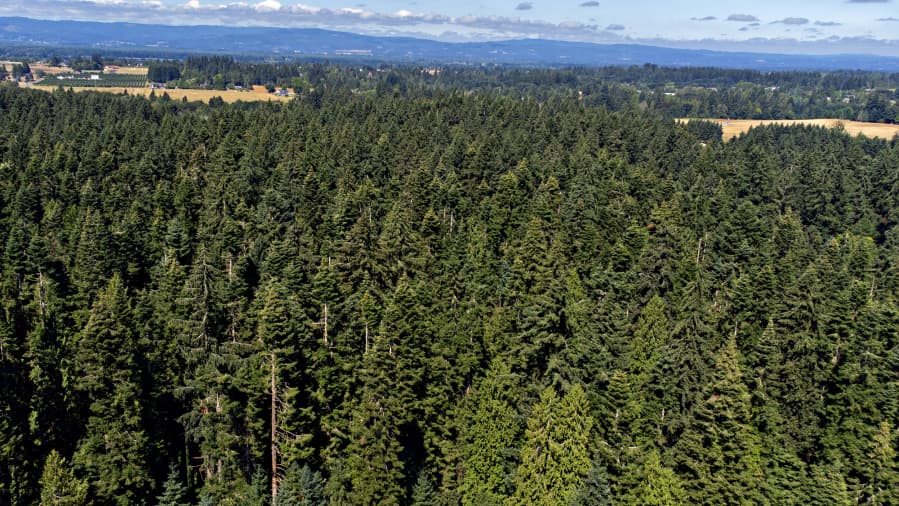When it comes to nature versus nurture, a new study from an Oregon State University scientist found the most cost-effective way to manage forest regrowth for climate mitigation is actually a combination of both.
Jacob Bukoski from the OSU College of Forestry and seven other researchers compared data from thousands of reforestation sites in 130 low- and middle-income countries. The researchers found using a combination of the two approaches would be 44 percent better than natural regeneration alone and 39 percent better than planting by itself.
“Our study was somewhat a response to a perceived overemphasis on tree planting — people like to take active approaches,” Bukoski said Monday. (With natural regeneration, seedlings grow from whatever wind or wildlife carries into an area.)
Bukoski said the study only compared two of the many ways to expand tree cover.
While the study primarily looked at agricultural forest lands (that is, those harvested for wood products), it offers lessons that can be applied to urban forests and local wooded areas, Bukoski said.
“Basically, use a diversity of approaches for expanding tree cover in your jurisdiction if that is the goal. In some areas, natural regeneration may be perfectly capable of meeting your goals and needs. In other areas, perhaps you need to have a more active approach and plant seedlings or use interventions to promote natural regeneration of tree cover,” Bukoski said.
Trees play a key role in climate mitigation. Along with pulling carbon dioxide from the atmosphere and storing it, trees also provide shade that can reduce outdoor temperatures. In turn, that can reduce the amount of energy needed to cool a home. The study also found well-planned reforestation projects provide up to 10 times more low-cost, carbon removal potential than previously estimated.
The first-of-its-kind study was led by Conservation International, an environmental nonprofit based in Virginia, and published in the scientific journal Nature Climate Change.
Could the results of the study change how local or state officials approach managing urban and agricultural forest lands?
Duane Emmons from the state Department of Natural Resources said Washington generally requires reforestation following a timber harvest.
“You can do it by natural regeneration or by plantings. You just have to ensure that site reaches an appropriate restocking level after three to five years,” Emmons said. “Most landowners replant because replanting gets your forest established faster.”
For industrial landowners, Emmons said waiting for natural regrowth often isn’t a financially viable method. How DNR manages its more than 2 million acres of forested state trust lands is a bit different.
“We manage for both generating revenue and also for making our stands as resilient and healthy as possible,” Emmons said. “When we’re doing a regeneration harvest, we typically do replant and replant a mix of species — sometimes it’s two, sometimes it’s three (species) — and we also anticipate we’re going to get a certain amount of natural regeneration.”
One notable change is the number of species used when replanting. For decades, only one species of tree was required. It was often the Douglas fir. Emmons said that practice ended in the early 1990s, and replanting is now done with two, three or more different species. Other species of trees are also blown in or carried in by wildlife.
“We find, in those areas where we’re planting, even if it’s as low as two different species, we will often see in 20 years that we’re finding three to five different species growing. And that’s what we want,” he said.
Emmons said Washington’s tree geneticists work with landowners to determine which species best fits their property.
“We’re actively looking at what it’s going to be like in 100 years and are there seed sources from Oregon or maybe even California that are more adapted to the conditions we think we’ll see in 100 years.”
While state- and privately owned forest lands are often harvested for economic gain, the city of Vancouver has a different approach for its urban forest.
“We’re creating and enhancing a community forest for the people that live, work and play in Vancouver and for community health benefits — clean air, water and shade to reduce the heat island effect,” said Charles Ray, an arborist with the urban forestry program.
Ray said this leaves little room for natural regeneration because the city is focused on maximizing the right tree in the right location. He said the city is also focused on preserving existing plant communities, which can be lost during new development.
When a pre-development application comes in, he said staff will visit the site to document the trees, shrubs and bushes already there and on neighboring properties. Staff will then advise on what plants to keep, what to remove and what to add to best mimic the natural environment.
Ray said the city created an urban forest management plan in 2007 and updated it in 2023. The plan addresses climate change.
“As part of that, we’ve done canopy studies … to really help inform us on decisions and where we should be headed and what are the looming threats, like climate change, and how do you prepare for it,” Ray said of the plan.
The work seems to be paying off.
“Our tree canopy was 19 percent in 2019, 2020. It was 21 percent in 2021. We are slowly growing,” he said. “Our goal is 28 percent within the city by 2047.”
When it comes to managing forests, whether it’s commercial timber operations, state lands, private lands or urban forests, Bukoski said there is a message that applies to all.
“Generally speaking, we can let forests regenerate on their own, which is slow but cheap, or take a more active approach and plant them, which speeds up growth but is more expensive,” he said.
